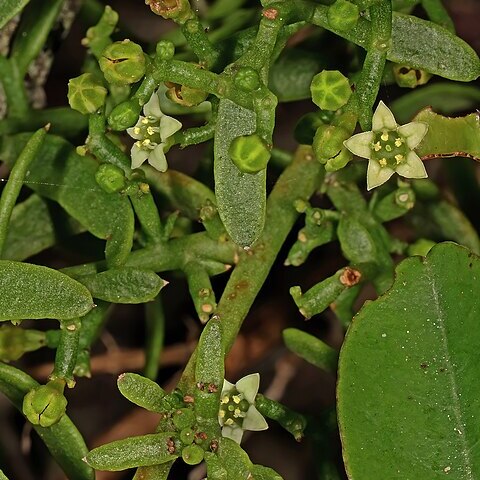Stems much-branched, terete below, upper angular and sulcate, glabrous; leaves linear or linear-lanceolate, subacute, 1/2-2 in. long, up to 1 1/2 lin. broad, flat, 1-3-nerved, or subacicular, somewhat fleshy, glabrous; inflorescence 1-to several-flowered, cymose; bracts leafy, often sickle-shaped and somewhat reflexed; peduncle mostly shorter than the bracts; bracteoles 2, minute; flowers subsessile; perianth 1 2/3 lin. long; segments triangular, about 1 lin. long, flat, hooded, glabrous; anthers exserted, 1/4 lin. long; filaments 2/3 lin. long; disc prominent, lobed; style 2/3 lin. long; fruit ovoid-globose, capped by the persistent perianth, 2 lin. long, 1 1/2 lin. in diam., coarsely reticulate.
Scrambling, hemiparasitic undershrub, 0.3-1.0 m high; rootstock stout, branches trailing, angular and sulcate when young. Leaves linear-lanceolate, flat or subterete, up to 45 mm long. Inflorescences axillary, cymules arranged in branched racemes. Bracts leaf-like, often longer than peduncles. Flowers whitish. Perianth 3.3 mm long; segments triangular, ± 2 mm long, flat, hooded, glabrous. Disc prominent, lobed. Flowering time Nov.-Jan. Fruit ovoid-globose, ± 4 mm long, including persistent perianth, coarsely reticulate.
Scandent herb, up to 500 mm tall. Leaves broadly linear or linear-lanceolate. Flowers in indeterminate branched racemes. Cymules 3-5-flowered. Peduncles elongated, divaricately branched. Flowers dull white or greenish yellow.
Scrambling, hemiparasitic undershrub with trailing branches angular and sulcate when young. Leaves linear, flat or subterete. Flowers in axillary cymules arranged in branched racemes, whitish.

